Saïs Report, March-April, 2002
Season Reports
Saïs Report, March-April, 2002
The team was in the field from 16th March to 16th April 2002 and consisted of Dr Penny Wilson (Durham University, Field Director), Nicola Harrington (Archaeologist), Drs Sylvie Marchand and Catherine Defernez (IFAO, Ceramicists), Dr Jacqueline Cotton (Archaeological Services Durham University, Environmental Scientist), Fatma Rageb Kamel (SCA Representative).
A number of field projects were continued in this short season.
Drill Cores
In order to complete the data collection for the Survey of Sais volume, a series of drill cores was made on the eastern side of the site, to ascertain the limits of the ancient settlement at this side. They also aimed to establish the relationship to the modern main road into Sa el-Hagar and the modern settlement along the road. On the eastern side the results from the augurs proved to be very consistent with coarse river sand and blue-black swamp sediments at the bottom of the cores. In most places this material was reached at around 6.00m below the ground surface, suggesting that river channels had once been very active in this area. Above this level in one place the cores brought up mortar and brick, more consistent with Roman period types than modern material, so there may be some kind of Roman building at this point. Two cores were also successfully made in the village: one in the police station and one in the floor of a house which was being demolished. In addition a core on the western side of the Great Pit brought up a good sequence of material consistent with that from the Predynastic levels on the west. It seems as if this material may continue under the western part of the modern village and that the Predynastic settlement does underlie the modern village.
The total of 111 cores should provide the required information to build up an idea about the settlement at Sa el-Hagar over the past few thousand years.
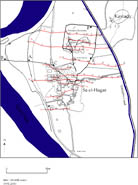
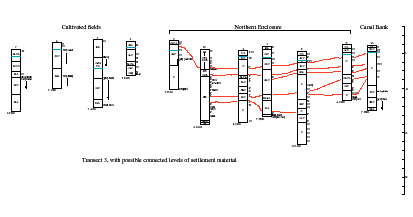
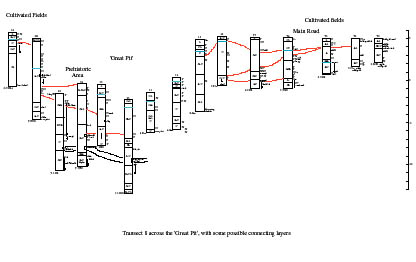
Above : Lithographic log of the transect, T7 (across the Great Pit).
Excavation at Kom Rebwa
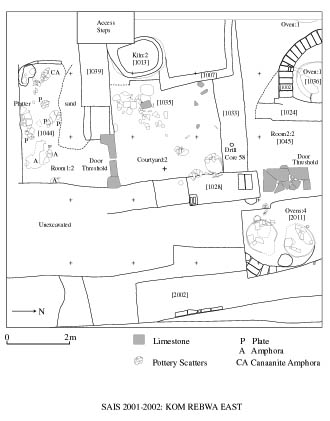
Left : Plan of excavation.
The Plan shows the excavation at the end of work. Each feature is labelled with a suggested phase added to it. Thus Oven:1, is an Oven at Phase 1; Ovens:4 are are ovens at Phase 4.
There are four main phases:
Phase 1 is the latest two ovens in the north west corner
Phase 2 D.18-Ramesside main sequence of surviving walls, Room 1 and Room 2, courtyard
Phase 3 date unknown wall sequence on east side
Phase 4 date to be established ovens within brick structure in north-east area
The complex stratigraphy of the chosen area and the large quantity of pottery from it meant that it was not possible to complete the work here. It was possible, however, to analyse the phasing of the site and to gain an idea about the actual physical material left behind. As suspected from the beginning of the work, the excavation area had been extensively pitted and disturbed. The work this year found another bread oven under a previously exposed wall, a second stone threshold entrance for a room or building running east-west and a courtyard area lying outside the building with the stone door jambs found last year. In addition the earliest phase of the site so far discovered was further excavated to reveal two circular ovens inside a circular mud brick enclosure, apparently running off under the Room 2 and also under the northern section.
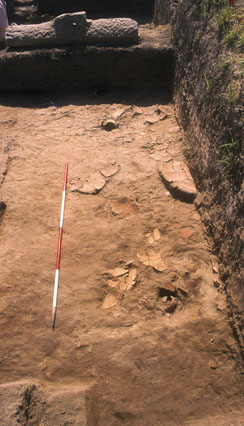
A suite of areas consisting of Room 1, a ‘courtyard’ and the large oven have been excavated down to floor level. A number of smashed plates, a Canaanite amphora, other types of amphora and several other vessels were found lying on the floors and the dating of these vessels may provide good information about the date of use of this area. These buildings could be part of a storeroom and food processing complex which would have continued to the south and west of our excavation area and may have been very substantial.
It is not so clear which way the second threshold associated with Room 2 is meant to lead. If it goes into a building to the east, then this has mostly disappeared due to pitting; if it goes to into a room to the west (Room 2), then at floor level here there is some sort of oven or kiln. It may be, however, an earlier phase and related to the ovens under the sand pit on the east.
Gradual excavation of threshold beside Room 2
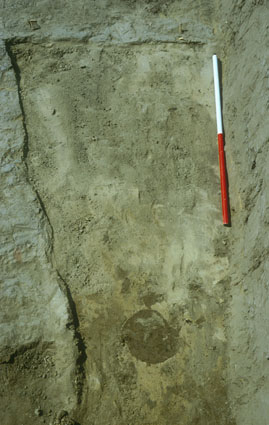
).
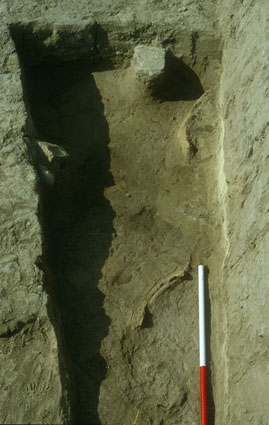
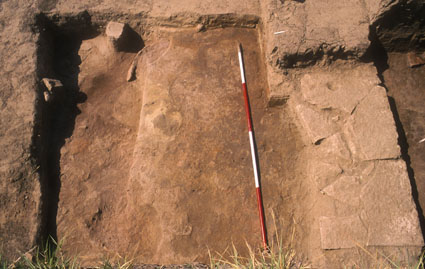
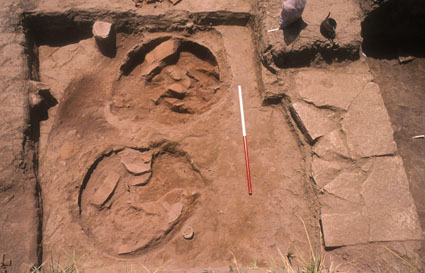
Again large quantities of pot sherds were found along with a fragment of inscribed red quartzite (with 7 hieroglyphs), a bronze kohl stick fragment, a bronze tang from a statue, a number of small ring beads, a fragment of powder blue glazed faience, animal and fish bones, a stone gaming piece, a fragment of a basalt offering table, some more terracotta cobra fragments and numerous pottery disks and pieces of pumice.
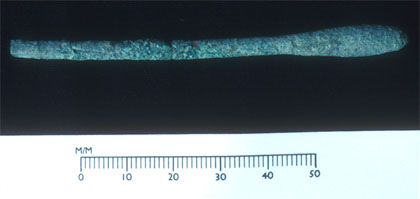
Drs Marchand and Defernez identified and drew the pottery from the Kom Rebwa sherd hill, the Great Pit section, field walking and sample trenching which we had collected in 2000. They also chose and made samples for the Laboratoire de Céramologie de l’Institut Français d’Archéologie Orientale in Cairo and a duplicate set for the Supreme Council of Antiquities.
The material suggested several important findings about the date of various parts of the Saïs area:
(1) In the Central area of the Northern Enclosure pottery had been collected from around Drill Core 17 and it proved to all be of Ptolemaic date, in particular the 2nd Century BC. As this material is at a lower depth than the current excavations in Kom Rebwa, it suggests that there is either a pit-feature here containing dumped Ptolemaic material, or that the Kom was higher than the surrounding landscape and that in the Ptolemaic period this area was used as a dump or even for settlement.
(2) Material collected from field walking in various areas proved to have a huge date range from the Late Period through to the modern period. This was an important result in that it suggested, as suspected, that field walking as used in European and British Archaeology might not be so helpful here in identifying sites. There is too much disturbance of the soil and too much has been brought from elsewhere.
(3) Pottery from the foundation trenches on the west of the Great Pit proved to be of Late Period date, specifically covering the range 6th-4th century BC which is of interest for trying to date the activity in this area. Though the archaeology here is very complex due to the destruction of the temple buildings in this area (as shown by the SCA trenches from 1998-1999), the date range suggests that there was little Ptolemaic activity here. Clearly further work here could be interesting, from the point of view of the pottery typology, though the archaeological context for it would not be so secure.
(4) Pottery from the Kom Rebwa sherd piles was of Late Ramesside through to Third Intermediate Period date, consistent with the pottery from our Excavation 1. Again this suggests that any later material has been removed completely from this area, if it was ever there.
(5) The pottery from Section 1 made on the west side of the Great Pit had a date range of the 6th-5th century BC more consistent with the material from the destruction debris above. Indeed this segment of land is the stratum between the modern ground level and the foundation levels. It suggests that this portion of land and possibly that under the western track and western houses is undisturbed in modern times and could be excavated.
(6) Further comments on the pottery from Excavation suggest that the material is is a fairly homogeneous group running from the end of the New Kingdom (Dynasty 18) into the Ramesside Period (Dynasty 19) and with some Late Period pottery in the uppermost fill. There is also some, possibly intrusive, Old Kingdom-First Intermediate Period pottery and some ‘Medum Bowl’ sherds.
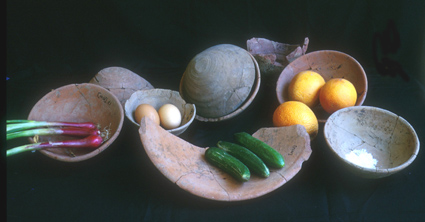
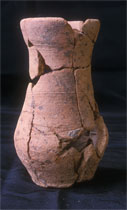
Environmental Sample Analysis
Dr Jacqueline Cotton processed and analysed 43 samples taken from a variety of contexts at Saïs. The results from the analysis were very useful and have shown that there is good preservation of plant remains and that they can be an important part of the site analysis.
Excavation 3
The samples are consistent with this area containing material from a settlement context where emmer wheat was cultivated and also possibly flax. In addition, catfish and synodontis fish also provided a good part of the diet along with beef and pork, as found from the bone record. Together with the bone report by Dr Salima Ikram, this means that all data for this excavation is now collected and can be written up as a preliminary report.
Excavation 1
The samples tested here again show a settlement zone with the cultivation of emmer-wheat and also with access to a wide variety of plant material, for example a sample from inside Oven 2 [1013] contained: charred plant material, a fish bone, a small mammal bone, 137 emmer glume bases, molluscs, 11 degraded cereals, 3 grass seeds, 1 possible lotus seed.
Conclusion
The work this season and from ongoing studies has continued to show that Saïs has had a much earlier history and that this can now be dated to the Neolithic period around 4,500 BC at least. Saïs was probably at least a double-city, like its sister city Buto, with important cult centres to the south (Great Pit) and in the north (Northern Enclosure), both areas founded on geziras. The settlement here was subject to the changes brought by the Nile and its flood and at times these could have been destructive, as suggested by the alluvial mud covering settled areas in the Northern Enclosure. The city has an important late Old Kingdom area perhaps in this zone and had certainly recovered and was vital in the New Kingdom. Throughout the Ramesside Period and Third Intermediate Period there were large food processing complexes at the site. The temple complexes of the Late Period have not survived so well in the archaeological material, but the pottery hints at the wealth and power of the city at that time and strata may still exist with information on the west of the site. There continued to be activity here in the Ptolemaic and Roman periods, maybe with the city shrinking back towards the modern village of Sa el-Hagar and as shown by SCA work in this area. The long history of this fascinating site is slowly being unravelled.
Dr Penny Wilson
Durham,
4th October 2002
Acknowledgements
The Chief Inspectors in Tanta Abdel Fattah Eid Ali and Said Zaki el-Ghainy again expedited all our work and arrangements. Thanks are due to the local guards at Sa el-Hagar, the police at Bassioun and Tanta for helping our work to go smoothly and with good humour, to our workmen, to Senne el-Bishe and Ashraf el-Bishe for running our household and, as always, to Mrs Rawya Ismail (EES) and the Committee of the SCA and its Officers in Cairo. I am also grateful to Dr Bernard Mathieu, the Director of the French Institute in Cairo, for loaning us his ceramicists.
